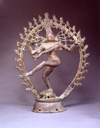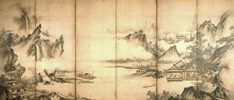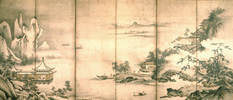 |
  |
|

|
|
| |
Malavika
Sarukkai |
| |
Malavika Sarukkai
is a dancer and choreographer. She was born in Bombay and studied
in Chennai (Madras) before deciding at age 16 she would be a dancer.
She first appeared on stage in 1972; 10 years later Sarukkai was
a solo performer at the Queen Elizabeth Hall, London, during the
Festival of India and soon began creating her own dances. Sarukkai
has performed throughout India, in the United States, Europe, and
Japan. She received a Senior Fellowship and a Grant from the Department
of Culture, Ministry of Human Resources, Government of India, and
the Haridas Sammelan, the Telugu Academy, the Sanskriti, and the
Kalaimamani awards. Her work includes excerpts from Kamba Ramayana,
Kuruntokai, Krishna Karnamrtam, Bhagavata Purana, Tulsidas Ram Charith
Manas, and Sivashtapadi.
Selected
Objects
|
|
 |
|
 |
| |
 |
Shiva as Lord
of the Dance
(Shiva Nataraja)
India, Tamil Nadu
Chola period, about 870
Copper alloy
H. 26 3/4 in. (67.9 cm); 1979.20
|
|
This icon speaks of
the ever dancing cosmos. I am awed by the iconographic
representation of Shiva as Nataraja, the cosmic dancer. His face is radiant
with serenity and the energy of stillness while his body pulsates with
the energy of cosmic activity in the cycle of Mahakal or Great Time. There
is a simultaneity-of stillness and movement, of creation and dissolution.
And the dance goes on… To Nataraja, Lord of the Dance, I pay homage.
|
| |
 |
Head of Bodhisattva
Avalokiteshvara
Indonesia, Central Java
9th century
Volcanic stone
H. 21 1/4 in. (54.0 cm); 1979.86
|
A
deeply calm inward gaze, gentleness carved from volcanic stone, a stilling
of time in a moment of silence. The scarred and pitted surface reflects
the ravages of time-yet the image endures. I am moved by this superb example
of Buddhist art, an eloquent statement of overcoming the transitory. In
the presence of such a gravely tender gaze one feels the flow of compassion.
|
| |
 |
Bottle
China, Jiangxi Province
Ming period, early 15th century (probably Yongle
era 1403-1424)
Porcelain with incised design under glaze (Jingdezhen ware)
H. 12 1/2 in. (31.8 cm), W. 8 1/8 in.; 1979.156 |
Looking
like frozen moonlight, ethereal yet practical-a bottle. Its harmonious shape,
at once seemingly round, is liquid with beauty. The shape and color recall
a white lotus, fragile yet firmly rooted in the earth. The bottle reaches
upwards, like a lotus thirsting for rain; it suggests a deep yearning to
be filled. By what? Moonlight, water, spirituality....
|
| |


|
Attributed to
Odawara Kana school
The Four Seasons
Japan
Muromachi period, mid-to late-16th century
Pair of six-panel folding screens; Ink and light color on paper
Each 61 x 142 1/8 in. (154.9 x 361.0 cm); 1979.216.1-2
|
Two
six-paneled screens that may be seen together, or folded to contemplate
one season at a time compressing functionality with artistry. A river winds
through the four landscapes, each sharp with the season's flavor, each depicting
the benevolence of nature. Each season is linked to the next, and the human
within it links with nature. These superbly reflective screens mirror beauty
and harmony. Human dwellings nestle in mountainous crags and riverfronts,
reflecting the same tones in color and emotion, suggesting merging, cyclicity,
hope…
|
| |
 |
Railing
Pillar with a Woman beneath a Tree (Shalabhanjika)
India, Uttar Pradesh, Mathura area
Kushan period, 2nd century
Sandstone
H. 30 3/4 in. (78.1 cm); 1979.1
|
| The
woman has been celebrated in Indian art as a symbol of fertility. We do
not know if this shalabhanjika is standing outside a Hindu, Buddhist,
or Jaina shrine. This secret seems to be reflected in the mysterious smile
on her face; she seems at once emerging and retreating into the tree, so
that the human and vegetal seem inseparable. Heavy fruit accentuate the
fullness of her hips and breasts. She draws you into her world of abundance
permeated with the sap of life. She is an early echo of the many later shalabhanjikas
who have entranced me in Bharhut, Sanchi, Ellora, Khajuraho. She is often
reflected in my work and comes to life in Pratipsa - The Song
of the Tree in my recently choreographed production Uthkanta-Longing. |
| |
|
|
| |
|
|
|





